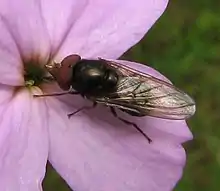Rhingia
Rhingia is a genus of hoverflies. They all have a very distinctive long snout. The larvae are associated with animal dung. Adults feed on nectar and pollen.[2]
| Rhingia | |
|---|---|
 | |
| Rhingia campestris female | |
| Scientific classification | |
| Domain: | Eukaryota |
| Kingdom: | Animalia |
| Phylum: | Arthropoda |
| Class: | Insecta |
| Order: | Diptera |
| Family: | Syrphidae |
| Tribe: | Rhingiini |
| Genus: | Rhingia Scopoli, 1763 |
| Type species | |
| Conops rostrata[1] | |

Rhingia nasica male
Species
- R. austriaca Meigen, 1830
- R. borealis Ringdahl 1928
- R. caerulescens Loew, 1858[1]
- R. campestris Meigen, 1822
- R. cnephaeoptera Speiser, 1915[1]
- R. coerulea Bezzi, 1912[1]
- R. congensis Curran, 1939[1]
- R. cuthbertsoni Curran, 1939[1]
- R. cyanoprora Speiser, 1910[1]
- R. formosana Shiraki, 1930
- R. fuscipes Bezzi, 1915[1]
- R. laevigata Loew, 1858
- R. lutea Bezzi, 1915[1]
- R. mecyana Speiser, 1910[1]
- R. nasica Say, 1823
- R. nigra Macquart, 1845 [3]
- R. orthoneurina Speiser, 1910[1]
- R. pellucens Bezzi, 1915[1]
- R. pulcherrima Bezzi, 1908[1]
- R. pycnosoma Bezzi, 1915[1]
- R. rostrata (Linnaeus, 1758)
- R. saskana Szilády, 1943[1]
- R. semicaerulea Austen, 1893[1]
- R. trivittata Curran, 1929[1]
References
- Smith, Kenneth G.V.; Vockeroth, J.R. (1980). Crosskey, R.W. (ed.). Catalogue of the Diptera of the Afrotropical Region. London: British museum (Natural History). pp. 1–1436. ISBN 0565-00821-8.
- Stubbs, Alan E. & Falk, Steven J. (1983). British Hoverflies: An Illustrated Identification Guide. British Entomological & Natural History Society. pp. 253, xvpp. ISBN 0-9502891-4-0.
- Marinoni, Luciane; Thompson, F. Christian (2003). "Flower flies of southeastern Brazil (Diptera: Syrphidae) Part I. Introduction and new species". Studia Dipterologica. 10 (2): 565–578. ISSN 0945-3954.
This article is issued from Wikipedia. The text is licensed under Creative Commons - Attribution - Sharealike. Additional terms may apply for the media files.